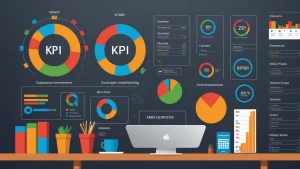Navigating the supply chain landscape in 2024 without mastering its vital metrics and KPIs is akin to sailing the Atlantic with a faulty compass. Lost? Possibly. Drowned in complexity? Definitely.
But, what are the most important supply chain metrics and KPIs for your business?
Knowing them can mean the difference between streamlined operations and operational chaos.
We’re here to help you find your compass. This guide will give you clarity, providing a comprehensive grasp of these crucial numbers, transforming your business trajectory, and ensuring you stay above the chaotic waves.
Get ready to navigate these waters with confidence, and leave the lifebuoy safely onboard.
Unveiling the Essential Supply Chain KPIs for Business
Inventory Turnover
Inventory Turnover is the speed at which a company sells and replaces its inventory within a specific period. It’s a vital indicator of inventory efficiency, profitability, inventory velocity, and how effectively you’re managing the balance between your stock and demand. Discover the essential Inventory Management Key Performance Indicators (KPIs) to enhance your inventory turnover and optimize stock levels for better financial performance.
The importance of Inventory Turnover lies in its ability to highlight issues in a company’s stock management. High turnover often indicates robust sales or effective inventory control, whereas a low inventory turnover rate may signify weak sales and excess inventory.
A focus on Inventory Turnover allows for actions to be aimed at striking the perfect equilibrium between stock availability and demand. Striking this balance can mean decreased holding costs, minimizing wasted stock, increasing efficiency, and ultimately, a healthier bottom line.
Inventory Turnover Ratio
The ideal inventory turnover ratio for most industries is between 5 and 10, indicating that a company sells and restocks its inventory approximately every one to two months
Order Tracking
At the heart of any efficient supply chain lies Order Tracking, which is the process of keeping tabs on your products as they transition from the warehouse to the customer. And it’s not just about ensuring timely delivery; it’s also about faith and transparency in the process.
Critical to the client experience, Order Tracking can impact customer satisfaction, loyalty, and ultimately a company’s reputation. It allows companies to identify any delivery issues timeously and rectify them promptly. It also empowers customers with information and assurances about their purchases. Discover which key performance indicators (KPIs) for order management can elevate your operational effectiveness and foster greater consumer happiness.
Investing in precise purchase order creation date-tracking processes can also offer critical insights into delivery performance trends. It might highlight areas in the supply chain susceptible to delays, allowing for targeted improvement strategies.
Cash-to-Cash Cycle Time
The Cash-to-Cash Cycle Time is a supply chain metric that measures the time it takes for a company to convert its investment in inventory and other resources into cash flows from sales. Essentially, it’s the time lag between the moment a business pays for raw materials and the moment it receives a cash flow as payment for a sold product.
The importance of this KPI cannot be underestimated. Businesses with a shortened Cash-to-Cash Cycle Time typically maintain a lower inventory-to-sales ratio. They manage their payables effectively and collect their receivables promptly. It effectively means improved liquidity and a better overall financial posture for such firms.
Reducing the Cash-to-Cash Cycle Time can free up capital for investment in other areas of the business, supporting growth and competitiveness. Monitoring this KPI can provide insights into a company’s financial management and offer opportunities for strategic improvements.
Supply Chain Cycle Time Statistics
Supply chain cycle time measures the time it would take to complete a customer's order if all stages were performed sequentially. A shorter cycle time indicates a more efficient and responsive supply chain
Cash-to-Cash Cycle Statistics
The cash-to-cash cycle measures the time between when a company sends cash to suppliers and when it receives cash from customers. Best-in-class companies tend to have a cash conversion cycle of less than a month

Join Metrobi driver network and earn up to $1,200 / week
With Metrobi, you can deliver for local businesses and make up to $1,200 per week.
Delving into the Supply Chain Metrics for Business Success
Perfect Order Rate
The perfect order rate plays a striking role in measuring supply chain efficiency. This metric, put plainly, signifies the percentage of orders that go through without a hitch – no issues with delivery, quality, quantity, or invoicing. It’s a comprehensive measure that reflects just how smooth your operations are and how likely you are to retain your customers.
– Higher perfect order rates denote a system that operates smoothly, leading to greater customer satisfaction rates.
Failing to meet your customers’ expectations can catapult your operations into turmoil. Ensuring a high perfect order rate allows your business to avoid common pitfalls such as Returns, and underscore your reliability as a supplier.
Freight Cost per Unit
Next on the list is freight Cost per Unit, a measuring stick of how much you shell out to move goods. More specifically, this indicates the cost involved in transporting each unit of your inventory. This metric is more than just numbers; it’s a poster child for operational efficiency and impacts your competitiveness in the market.
– Low freight costs can mean better profit margins
For businesses operating on razor-thin margins, optimizing this figure could mean the difference between a rousing success or a dismal failure. The ability to manage this cost effectively will keep you ahead of the competition.
Average Days to Sell Inventory
Finally, we dissect Average Days to Sell Inventory – a metric that reflects not only inventory management but also demand prediction and product relevance.
In simple terms, this measures how long goods collect dust on your shelves before they find a home with customers.
– Lower scores on this metric demonstrate a fast-paced, responsive operation that’s in tune with market demand.
By tracking inventory days of supply with this metric, you can gauge product relevance, ensuring your supply keeps in step with the rhythm of your customer demand. Rest assured knowing this metric can aid in preventing capital from being tied up in unsold goods, thereby enhancing operational efficiency and overall profitability.
With these metrics and their implications in mind, you’re well-equipped to take your supply chain logistics operations from good to great. Know that these are your allies in your journey toward operational excellence and improved profitability. Uncover essential transport management performance indicators that will propel your operational effectiveness and cost reduction strategies in your supply chain logistics.
The Role of KPIs in Supply Chain Management
Enhancing Efficiency
Performance is often gauged by measuring the efficiency of top supply chain metrics. Key Performance Indicators (KPIs) in supply chain management serve as yardsticks to evaluate just this – the efficiency of your processes.
With these invaluable metrics, businesses can pinpoint areas that require optimization.
High-performing segments can also be recognized, setting the standard for other sectors.
KPIs can identify process bottlenecks or even subtle inefficiencies that fly under the radar. This provides an opportunity to act preemptively before a minor hitch turns into a significant problem.
You can essentially use KPIs to keep the engine of your supply chain humming smoothly.
KPIs – The Beacon of Efficiency
Think of KPIs as headlights of an automobile, illuminating the road ahead and highlighting potential hazards.
By tracking these performance indicators, businesses can anticipate future challenges and optimize their processes in response.
Just as a driver adjusts speed by road conditions, a business can alter its entire supply chain process, guided by KPIs, to achieve maximal efficiency.
Facilitating Decision Making
When faced with a crossroads, businesses need to make the most informed decision. KPIs provide that informational backbone to support decision-making processes.
By keeping a close eye on performance indicators, businesses are armed with concrete data that can influence the path they choose.
Decision-making is no longer about going with your gut or leaning on past experiences. With KPIs, it becomes an exercise in data analytics.
Patterns, trends, and performance insights from KPIs guide the directions that businesses take.
Importance of KPIs in Decision-Making Process
Utilizing KPIs allows businesses to make data-driven decisions, leading to a competitive edge, increased profitability, and long-term success
Propel Informed Decisions with KPIs
In the realm of supply chain management, acting on concrete data beats intuition.
Data-driven decision-making lets you streamline processes and improve efficiency.
KPIs serve as a lighthouse guiding you away from potential negative impacts.
Improving Customer Satisfaction
Happy customers are the cornerstone of any successful business. Yet, this seemingly simple formula can be the most challenging to achieve.
Customer satisfaction is influenced by numerous variables – timely deliveries on the actual delivery date, product quality, after-sales service, and more.
And how does a business keep track of these multiple facets? You guessed it – through KPIs.
The Power of KPIs in Driving Customer Satisfaction
Customer satisfaction KPIs can shed light on various aspects of the supply chain and customer demands – from order processing time to delivery reliability. By monitoring these, you can proactively identify any potential issues and take corrective measures before the customer is affected.
If a particular stage in the supply chain consistently underperforms, KPIs can flag the need for improvement.
Now, there’s no universal set of KPIs that would apply to all businesses. It’s vital to identify the ones that align with your business goals and meet customer demands and expectations. Remember, KPIs are more than just measurements; they are the stepping stones to a more efficient, customer-centric business.
Supply Chain Metrics Statistics
The fill rate, or demand satisfaction rate, is the amount of customer demand that is met through stock availability, without backorders or lost sales. Improving supplier-retailer relationships can lead to an 80% improvement in fill rate
Improving Business with Supply Chain Metrics
Reducing Costs
Recognize efficiency gaps
Supply chain metrics can be instrumental in identifying inefficiencies within your operation. By keeping a detailed overview of performance data, discrepancies or challenges within your system can be swiftly identified. For instance, high transportation costs or low average inventory turnover can point to potential areas for improvement. Once these issues are identified, you can formulate strategies to address them. Consequently, maintaining an efficient and lean, supply chain operation is a major component of cost reduction for businesses.
Enhancing Productivity
Streamline processes
Supply chain metrics have a crucial role in system optimization for an organization. Assessment of cycle times, order fulfillment rates, or warehouse throughput can not only aid in recognizing bottlenecks but also in maximizing process efficiency. Metrics such as order accuracy and on-time delivery reports can heighten customer satisfaction and improve reputation. In essence, the appropriate supply chain metrics dashboard can assist in delivering more products, faster, and with increased accuracy – leading to an enhanced level of productivity.
Supply Chain Metrics Statistics
Key quantitative metrics like inventory turnover, customer order fulfillment rate, on-time delivery rate, and cost per unit provide a clear view of supply chain performance and enable numerical data comparison and analysis
Boosting Profitability
Make informed decisions
Supply chain metrics serve as a treasure trove of analytical data for strategic decision-making. By tracking metrics related to cost of goods sold (COGS) and gross margin, businesses can identify areas of waste or overspending. This information is key in augmenting the gross profit percentage and margins. Furthermore, metrics around customer service level and order accuracy can enhance customer loyalty, opening doors for repeat business and possibilities for increased revenue. In a nutshell, metrics offer an insightful perspective to increase profitability through informed strategic decisions. Learn how refining your strategies around the On Time Delivery Key Performance Indicator can further amplify customer satisfaction and loyalty, leading to enhanced profitability.
How do supply chain metrics affect the profitability of business operations?
Metrics like inventory turnover, order fill rate, and on-time delivery rate provide insights into the efficiency of supply chain operations. Improving these metrics leads to streamlined processes, reduced lead times, and enhanced customer satisfaction, ultimately contributing to increased profitability
Understanding Supply Chain KPIs and Metrics
Supply Chain KPIs are crucial in gauging the efficiency of business processes.
Metrics provide concrete data needed for sound decision-making.
The fundamental difference between KPIs and metrics lies in their application, and understanding this can revolutionize your approach to the supply chain.
What are Supply Chain KPIs?
The might of the Supply Chain Key Performance Indicators (KPIs) lies in their transformative ability to measure the success or failure of specific activities. Occupying a pivotal position, their role is instrumental in evaluating the efficiency, effectiveness, and performance of various segments within a supply chain. They’re a mirror showing a clear picture of how operations align with the business’s overall targets.
Ahead in time, KPIs are all about aiding goal-oriented decisions. They enable a meticulous examination of whether the current activities are leading the business down the right path or if a fresh course is needed.
What are Supply Chain Metrics?
Neglecting to measure supply chain performance doesn’t necessarily mean you’re failing to meet goals, but it leaves you in the dark about how you’re performing. The lighthouse in this darkness is supply chain metrics. Metrics, unlike KPIs, are quantitative measurements that reflect various aspects of a supply chain’s performance. They’re your radar detecting the highs and lows, your compass showing the path, and your odometer telling you how far you’ve come.
Being rich in data, metrics help paint a comprehensive picture of your supply chain efficiency and effectiveness. These data include various factors such as costs, fulfillment time, order accuracy, and customer satisfaction.
How Metrics Define Your Supply Chain
The grandeur of metrics is in the way they capture all aspects of your supply chain. From the minute details of process efficiency to the broad panorama encompassing the entirety of operations, metrics shed light on it all. Informative and reliant, they enable a business to achieve a level of understanding necessary for making accurate and performance-enhancing decisions.
The Difference between KPIs and Metrics
Even though KPIs and metrics both measure performance, they are not interchangeably usable. The divergence lies in the application. While a KPI is a type of metric that illustrates how effectively an organization is achieving a key business objective, not all metrics are KPIs. In essence, all KPIs are metrics, but not all metrics are KPIs.
Delving deeper, we find that KPIs are strategic, chosen based on their relevance to the desired outcomes, and aligned with specific goals. Metrics, on the other hand, may or may not align directly with overarching organizational objectives. Despite this, they remain useful for providing insight into operations and for performance evaluation.
The Future of Supply Chain Metrics and KPIs
The Impact of Technology on Supply Chain Metrics and KPIs
New technologies are reshaping how supply chain metrics and KPIs are gathered and analyzed. We are at a tipping point where technological resources facilitate real-time monitoring and more accurate decision-making.
For instance, IoT devices capture vast data on warehouse activities, transport conditions, and product statuses. This means that businesses can monitor key performance indicators such as inventory accuracy, on-time delivery, and order cycles more efficiently.
For businesses where time is scarce, technology provides the tools for swift, informed decisions. The shift from manual to automated data collection is not only improving the accuracy of supply chain metrics but also allowing companies to respond proactively to changes.
From IoT devices to cloud technology and automation, businesses are increasingly utilizing the power of technology to drive their supply chain metrics and KPIs.
The Role of AI and Machine Learning in Supply Chain Metrics and KPIs
Artificial Intelligence (AI) and Machine Learning (ML) are getting increasingly entangled in the world of supply chain management. They’re opening up entirely uncharted territories in terms of predicting and managing supply chain metrics and KPIs.
Through AI, companies can predict consumer trends, analyze risks, improve order accuracy, and even aid demand forecasts. It’s drastically reducing the margin for error and proving to be a game-changer for businesses who are willing to embrace it.
Machine learning, a subset of AI, is evolving the prediction accuracy of supply chain KPIs. By ingesting vast amounts of data, machine learning algorithms can improve predictive capabilities, allowing businesses to anticipate demand and avoid inventory imbalances.
The Importance of Sustainability in Supply Chain Metrics and KPIs
For today’s consumers, a company’s environmental footprint is becoming as important as the quality of the products they offer. Businesses are responding by introducing sustainability goals into their supply chain metrics and KPIs.
Benchmarking CO2 emissions, energy consumption, water usage, and even social factors like fair trade and working conditions are gradually becoming essential in measuring supply chain performance. It doesn’t just make good ethical sense – many businesses are also finding that sustainable operations can reduce supply chain costs and improve reputation.
In this era of environmental awareness, incorporating sustainability into supply chain metrics and KPIs is an essential strategy, and it’s only going to become more prominent in the future.
Charting Your Path Towards Supply Chain Success
Understanding supply chain metrics and KPIs is crucial in the modern business landscape. We’ve delved into the specifics – from OTIF and Perfect Order Rate to Average Days Inventory and Cash Conversion Cycle. Harnessing these parameters can lead to significant cost savings, enhanced customer satisfaction with customer order cycle time, and a leap in overall efficiency. Identify the performance indicators in distribution that are pivotal for your enterprise to enhance operational efficiency and stimulate expansion.
This knowledge isn’t just informative, it’s transformative. It provides the analytical prowess to make informed decisions, streamline operations, and grow with changing market dynamics. With this comprehension, you’ve got the controls to your supply chain success aircraft.
Now, armed with this information, it’s time to apply it. Audit your existing supply chain processes, evaluate them against these key metrics, and start tweaking. Remember, it’s the continuous, consistent monitoring and adjusting that truly makes the difference.
As you embark on this next phase, ask yourself, where does your biggest opportunity for improvement lie within your current supply chain performance?
So gear up and steer your business towards uncharted growth territories. After all, when you master your metrics, you master your business.





























